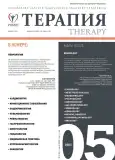Damage of nervous system in COVID-19: Neuropsychological syndromes, histological data
- Authors: Mashin V.V.1, Belova L.A.1, Dudikov E.M.1, Slesareva E.V.1, Dolgova D.R.1, Nikishin K.E.1, Lyalchenko Y.A.1
-
Affiliations:
- Ulyanovsk State University
- Issue: Vol 9, No 5 (2023)
- Pages: 32-37
- Section: ORIGINAL STUDIES
- Published: 15.05.2023
- URL: https://journals.eco-vector.com/2412-4036/article/view/569029
- DOI: https://doi.org/10.18565/therapy.2023.5.32–37
- ID: 569029
Cite item
Abstract
Recently, the increasing evidence that COVID-19 can cause severe cognitive and emotional disorders is appearing.
The aim: to estimate the character of neuropsychological and emotional disorders in patients during the period of clinical manifestations of a novel coronavirus infection COVID-19, to perform morphological assessment of the brain condition of deceased patients.
Material and methods. The results of a survey of 112 patients in the period of COVID-19 clinical manifestations are introduced. The mean age of all patients was 61,7±11,5 years. COVID-19 diagnosis was confirmed by instrumental (CT/chest X-ray examination) and laboratory methods (PCR test for SARS-CoV-2 coronavirus RNA presence). Screening testing of cognitive functions (MOCA test) was performed for neuropsychological status assessment. A morphological estimation of the macroscopic parameters and micropreparations of the brain in patients who died from COVID-19 was made. Cerebral cross sections of 20 μm and 5–6 μm thick were stained with hematoxylin-eosin.
Results and conclusion. In the structure of cognitive impairments in COVID-19 patients, optical-spatial disorders occupy the most common place. Morphological studies confirmed the presence of a full-blown plethora and thrombosis of small vessels, mainly in the parieto-occipital regions and vessels of the basal brain surface. The histological picture corresponds to an acute viral lesion of the brain substance with an active reaction of glia, microvessels and significant dystrophic processes both in the bodies of neurons and nerve filaments.
Full Text
About the authors
Victor V. Mashin
Ulyanovsk State University
Author for correspondence.
Email: victor_mashin@mail.ru
ORCID iD: 0000-0003-0085-3727
MD, Professor, Head of the Department of Neurology, Neurosurgery and Medical Rehabilitation of the Faculty of Medicine
Russian Federation, UlyanovskLyudmila A. Belova
Ulyanovsk State University
Email: labelova@mail.ru
ORCID iD: 0000-0002-9585-5604
MD, Professor of the Department of Neurology, Neurosurgery and Medical Rehabilitation, Dean of the Faculty of Medicine
Russian Federation, UlyanovskEvgeniy M. Dudikov
Ulyanovsk State University
Email: dudikoveygene80@yandex.ru
ORCID iD: 0000-0002-4105-5687
Assistant at the Department of Neurology, Neurosurgery and Medical Rehabilitation of the Faculty of Medicine
Russian Federation, UlyanovskElena V. Slesareva
Ulyanovsk State University
Email: gistology2@mail.ru
ORCID iD: 0000-0003-3326-7863
MD, Professor of the Department of General and Clinical Morphology of the Faculty of Medicine named after T.Z. Biktimirov
Russian Federation, UlyanovskDinara R. Dolgova
Ulyanovsk State University
Email: dolgova.dinara@yandex.ru
ORCID iD: 0000-0001-5475-7031
PhD in Biological Sciences, Associate Professor of the Department of Physiology and Pathophysiology of the Faculty of Medicine named after T.Z. Biktimirov
Russian Federation, UlyanovskKirill E. Nikishin
Ulyanovsk State University
Email: kirill.nikishin93@mail.ru
ORCID iD: 0000-0003-0125-323X
Resident of the Department of Anesthesiology and Intensive Care, Resident of the Department of Surgery of the Faculty of Postgraduate Education
Russian Federation, UlyanovskYuri A. Lyalchenko
Ulyanovsk State University
Email: lyalchenko96@yandex.ru
ORCID iD: 0000-0002-8151-8068
5th year student of the Faculty of Medicine
Russian Federation, UlyanovskReferences
- World Health Organization. Coronavirus disease (COVID-19) weekly epidemiological update and weekly operational update. URL: https://www.who.int/emergencies/diseases/novel-coronavirus-2019/situation-reports (date of access – 01.06.2023).
- Bhaskar S., Bradley S., Israeli-Korn S. et al. Chronic neurology in COVID-19 era: Clinical considerations and recommendations from the REPROGRAM Consortium. Front Neurol. 2020; 11: 664. https://dx.doi.org/10.3389/fneur.2020.00664.
- Фурман Е.Г., Репецкая М.Н., Корюкина И.П. Поражение нижних дыхательных путей и легких при коронавирусной инфекции COVID- 1 9 у детей и взрослых: сходства и отличия (обзор литературы). Пермский медицинский журнал. 2020; 37(2): 5–14. [Furman E.G., Repetskaya M.N., Koryukina I.P. Lower airways and lungs affection in coronavirus infection COVID-19 among children and adults: Similarities and differences (review of literature). Permskiy meditsinskiy zhurnal = Perm Medical Journal. 2020; 37(2): 5–14 (In Russ.)]. https://dx.doi.org/10.17816/pmj3725-14. EDN: QWOJDW.
- Новикова Л.Б., Акопян, А.П., Шарапова К.М., Латыпова Р.Ф. Неврологические и психические расстройства, ассоциированные с COVID- 1 9. Артериальная гипертензия. 2020; 26(3): 317–326. [Novikova L.B., Akopian A.P., Sharapova K.M., Latypova R.F. Neurological and mental disorders associated WITH COVID-19. Arterial’naya gipertenziya = Arterial Hypertension. 2020; 26(3): 317–326 (In Russ.)]. https://dx.doi.org/10.18705/1607-419X-2020-26-3-317-326. EDN: PBXPCF.
- Saad M., Omrani A.S., Baig K. et al. Clinical aspects and outcomes of 70 patients with Middle East respiratory syndrome coronavirus infection: A single-center experience in Saudi Arabia. Int J InfectDis. 2014; 29: 301–6. https://dx.doi.org/10.1016/j.ijid.2014.09.003.
- Helms J., Kremer S., Merdji H. et al. Neurologic features in severe SARS-CoV-2 infection. N Engl J Med. 2020; 382(23): 2268–70. https://dx.doi.org/10.1056/NEJMc2008597.
- Mao L., Jin H., Wang M. et al. Neurologic manifestations of hospitalized patients with Coronavirus disease 2019 in Wuhan, China. JAMA Neurol. 2020; 77(6): 683–90. https://dx.doi.org/10.1001/jamaneurol.2020.1127.
- Roman G.C., Spencer P.S., Reis J. et al. The neurology of COVID-19 revisited: A proposal from the Environmental Neurology Specialty Group of the World Federation of Neurology to implement international neurological registries. J Neurol Sci. 2020; 414: 116884. https://dx.doi.org/10.1016/j.jns.2020.116884.
- Arabi Y.M., Harthi A., Hussein J. et al. Severe neurologic syndrome associated with Middle East respiratory syndrome corona virus (MERS-CoV). Infection. 2015; 43(4): 495–501. https://dx.doi.org/10.1007/s15010-015-0720-y.
- Ellul M.A., Benjamin L., Singh B. et al. Neurological associations of COVID-19. Lancet Neurol. 2020; 19(9): 767–83. https://dx.doi.org/10.1016/S1474-4422(20)30221-0.
- Machhi J., Herskovitz J., Senan A.M. et al. The natural history, pathobiology, and clinical manifestations of SARS-CoV-2 infection. J Neuroimmune Pharmacol. 2020; 15(3): 359–86. https://dx.doi.org/10.1007/s11481-020-09944-5.
- Eliezer M., Hautefort C., Hamel A.L. et al. Sudden and complete olfactory loss function as a possible symptom of COVID-19. JAMA Otolaryngol Head NeckSurg. 2020; 146(7): 674–75. https://dx.doi.org/10.1001/jamaoto.2020.0832.
- Huang C., Wang Y., Li X. et al Clinical features of patients infected with 2019 novel coronavirus in Wuhan, China. Lancet. 2020; 395(10223): 497–506. https://dx.doi.org/10.1016/S0140-6736(20)30183-5.
- Hashir A.A., Mufaddal N.D., Alifian A. et al. SARS-CoV-2 and the brain: What do we know about the causality of cognitive COVID? J Clin Med. 2021; 10(15): 3441. https://dx.doi.org/10.3390/jcm10153441.
- Rogers J.P., Chesney E., Oliver D. et al. Psychiatric and neuropsychiatric presentations associated with severe coronavirus infections: a systematic review and meta-analysis with comparison to the COVID-19 pandemic. Lancet Psychiatry. 2020; 7(7): 611–27. https://dx.doi.org/10.1016/S2215-0366(20)30203-0.
Supplementary files






